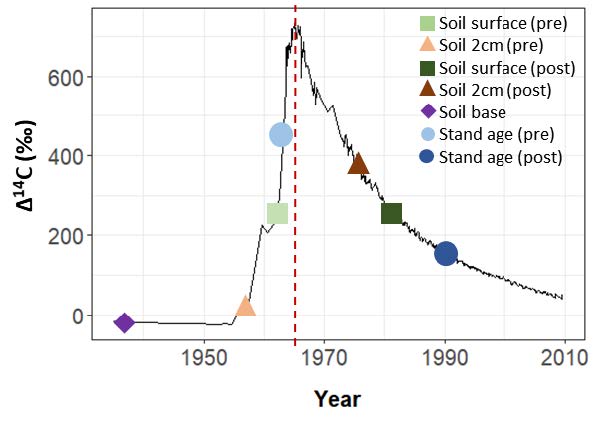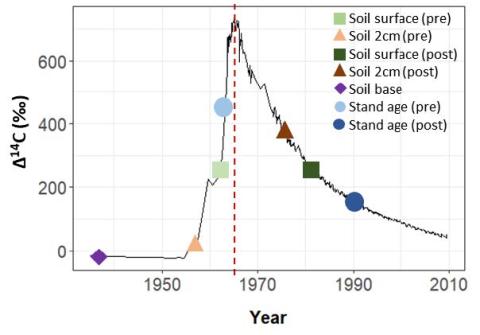ABoVE: Characterization of Carbon Dynamics in Burned Forest Plots, NWT, Canada, 2014
A new dataset from the Arctic-Boreal Vulnerability Experiment (ABoVE) provides insights into the effects of boreal forest fires on global carbon dynamics. Data were collected at boreal forests in the Northwest Territories, Canada, that were burned by wildfires in 2014. During fieldwork in 2015, 32 forest plots were selected that were dominated by black spruce and representative of the full moisture gradient across the landscape, ranging from xeric to sub-hygric. Plot observations included slope, aspect, and moisture. At each plot, one intact organic soil profile associated with a specific burn depth was selected and analyzed for carbon content and radiocarbon (14C) values at specific profile depth increments to assess legacy carbon presence and combustion. Vegetation observations included tree density, and stand age at the time of the fire was determined from tree-ring counts. Estimates of pre-fire below and aboveground carbon pools were derived. The percent of total NWT wildfire burned area comprising of "young" stands (less than 60 years old at time of fire) was estimated.
ABoVE is a NASA Terrestrial Ecology Program field campaign that links field-based, process-level studies with geospatial data products derived from airborne and satellite sensors, providing a foundation for improving the analysis and modeling capabilities needed to understand and predict ecosystem responses and societal implications. See all ORNL DAAC datasets from the ABoVE campaign.
Data Citation: Walker, X.J., J.L. Baltzer, W. Laurier, S.G. Cumming, N.J. Day, S.J. Goetz, J.F. Johnstone, S. Potter, B.M. Rogers, E.A.G. Schuur, M.R. Turetsky, and M.C. Mack. 2019. ABoVE: Characterization of Carbon Dynamics in Burned Forest Plots, NWT, Canada, 2014. ORNL DAAC, Oak Ridge, Tennessee, USA. https://doi.org/10.3334/ORNLDAAC/1664
Data Center: ORNL DAAC
Sponsor: EOSDIS


